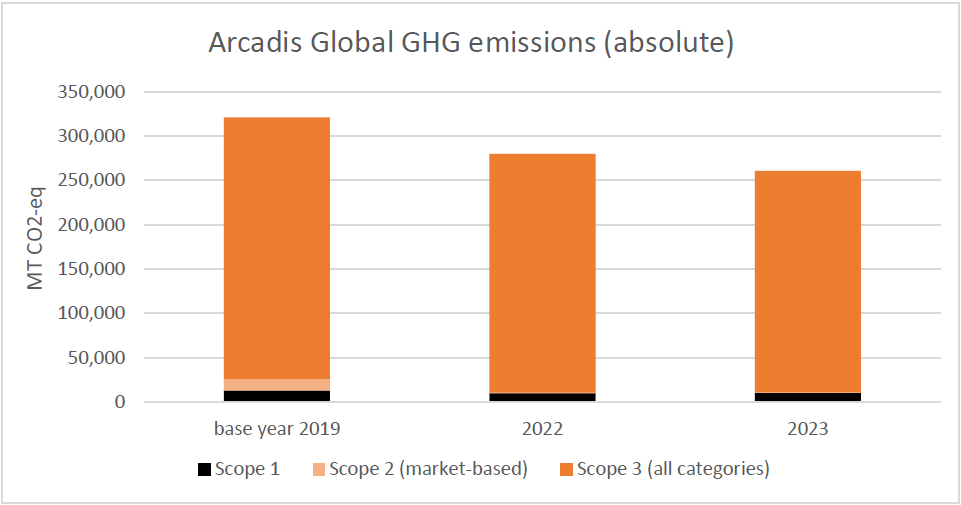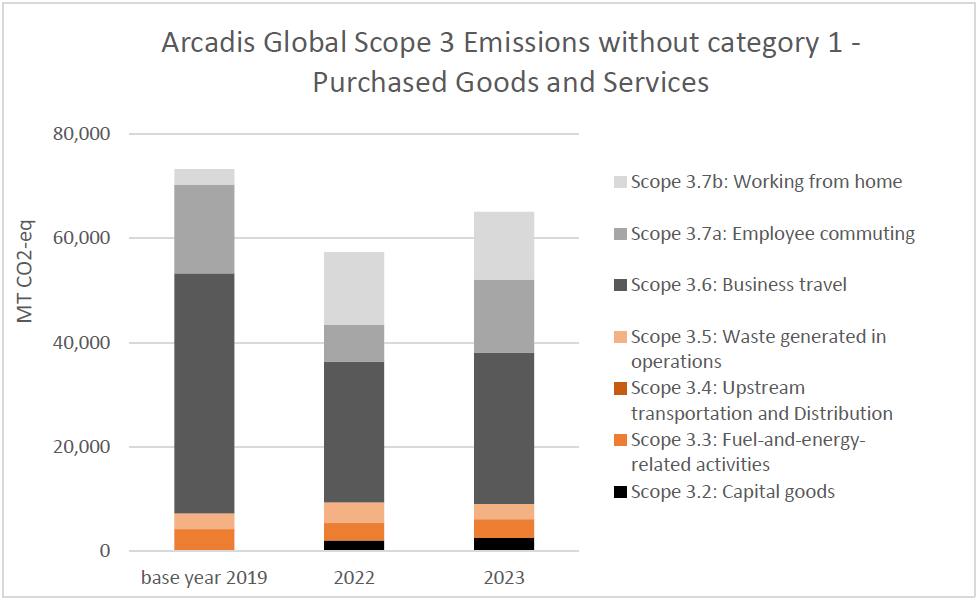We are contributing to the global effort to achieve sustainable development. Across our entire global company, we are working to reduce our carbon footprint and energy consumption, with a focus on travel and energy use in our offices. This is in line with the global effort to achieve the 2015 Paris Climate Agreement and the UN Sustainable Development Goals.

Our 2023 Carbon Footprint and Net Zero Commitment
Arcadis supports the Paris Agreement and Glasgow accords. Since February 2022 Arcadis has had a science-based target approved by the Science Based Target initiative (SBTi) for our global scope 1, 2, and 3 emissions aligned with a 1.5°C pathway and a net zero commitment. Since then, Arcadis grew through acquisitions and updated our scope 3 inventory, trigging an update to our baseline emissions and targets. Arcadis took this as an opportunity to make our science-based targets more ambitious. As part of our 2024-2026 strategy, we publicly announced our new near-term targets that are aligned with the new SBTi Net-Zero standard and which were submitted for approval by SBTi in January 2024.
In November 2023, Arcadis committed to achieving net zero across our value chain by 2035. Arcadis’ near-term net zero objectives are a reduction of absolute scope 1 and market-based scope 2 GHG emissions of 70% by 2026 from a 2019 base year (currently at -58%) and a reduction of absolute scope 3 GHG emissions of 45% by 2029 from a 2019 base year (currently at -17%).
As part of our efforts to reach these targets, we also committed to transition our entire company fleet to electric vehicles by 2030 (currently 26% of vehicles are EVs). Furthermore, Arcadis committed to reducing emissions associated with air travel by 50% (currently -29%) and business travel by 35% (currently achieved with -37%) by 2025 compared to our 2019 baseline emissions.
Arcadis achieved a 20% absolute reduction across scope 1, 2, and 3 GHG emissions from 2019 to 2023
Over that same timeframe, we achieved a 58% absolute reduction in scope 1 and 2 (market-based) emissions through our program to concentrate and consolidate our offices and by purchasing green energy. Whenever office relocations are planned, Arcadis will continue to consider energy source and use as a factor in selecting new office space. Our overall scope 3 emissions decreased 17%, led by a reduction in scope 3 category 1 (Purchased goods and services), offset by an increase in scope 3 category 7 (Employee commuting, including working from home). While our scope 3 Category 6 (Business travel) emissions declined versus the (pre-covid) base year, there was a significant increase in travel emissions in 2023 compared to 2022 resulting from increased travel to align the organization to our new business model, as well as increased client interaction.
Our detailed carbon footprint calculation methodology is described in our annual integrated report on page 76 and in the Glossary.
Table 1 : Arcadis Global Carbon Footprint in MT CO2eq (MT = metric tons)
Absolute values are rounded to 10; and in scope 3 to 100 or 1000| Absolute GHG emissions (MT CO2e) | base year 2019 | 2022 | 2023 |
| Scope 1 | 13,290 | 10,260 | 10,480 |
| Scope 2 (market-based) | 12,900 | 670 | 1,050 |
| Scope 2 (location-based) | 17,320 | 11,180 | 9,530 |
| Scope 3 (all categories) | 295,000 | 269,000 | 249,000 |
| Scope 3.1: Purchased goods & services | 222,000 | 212,000 | 181,000 |
| Scope 3.2: Capital goods | Included in cat 1 | 2,100 | 2,600 |
| Scope 3.3: Fuel-and-energy-related activities | 4,300 | 3,300 | 3,500 |
| Scope 3.4:Upstream transportation and Distribution | Included in cat 1 | 5 | 1 |
| Scope 3.5: Waste generated in operations | 3,000 | 4,000 | 3,000 |
| Scope 3.6: Business travel | 46,000 | 27,000 | 29,000 |
| Scope 3.6 - Air Travel only (included in Scope 3.6 Business Travel) | 31,000 | 16,000 | 22,000 |
| Scope 3.7: Employee commuting (incl. working from home) | 20,000 | 20,000 | 26,000 |
| Scope 3.7a: Employee commuting | 17,000 | 7,000 | 14,000 |
| Scope 3.7b:Working from home | 3,000 | 14,000 | 13,000 |
| Total Absolute Footprint (all scopes, market-based) | 321,000 | 279,000 | 260,000 |
| Relative GHG emissions (MT CO2e/FTE) | |||
| Scope 1 + 2 (market-based) / FTE | 0.98 | 0.33 | 0.34 |
| Scope 1 / FTE | 0.50 | 0.31 | 0.31 |
| Scope 2 (market-based) / FTE | 0.48 | 0.02 | 0.03 |
| Scope 3 / FTE | 11.0 | 8.2 | 7.3 |
| Scope 3.6: Business travel / FTE | 1.73 | 0.83 | 0.84 |
| Scope 3.6 - Air Travel only / FTE | 1.14 | 0.50 | 0.63 |
| Total relative Arcadis Footprint (all scopes, market-based) | 12.0 | 8.6 | 7.6 |
To enable our net zero transition, Arcadis is using a prioritized approach, enabled by improving data quality, to target the key sources of emissions within areas such as purchased goods and services. For each scope of emissions, Arcadis is implementing specific emissions reduction levers. For scope 1 and 2 emissions, this includes transitioning our fleet to electric vehicles and improving the sustainability of our offices. Arcadis routinely incorporates green clauses in our leases and gives preference to sustainably rated office properties accredited by third parties (e.g., LEED, BREAM), where possible. For scope 3 emissions, emission reduction levers include setting carbon travel budgets, implementing more globally consistent waste reduction and recycling measures, and working with suppliers via a third-party supply chain program to report and reduce emissions.
As required by the GHG Protocol, the comparative emissions and our 2019 baseline have been updated from previously reported greenhouse gas (GHG) emissions due to acquisitions, data improvements, estimation updates, and methodology changes (mainly related to scope 3 category 1) which has led to a more robust approach. We now also include primary supplier data collected through the CDP Supply Chain program. For a more detailed explanation of the changes, see our annual integrated report.
The GHG Protocol outlines requirements to restate emissions due to structural and methodological changes to allow for more accurate tracking of emissions over time. For more information see GHG Protocol Corporate Standard Chapter 5: Tracking Emissions Over Time.
Since 2010, Arcadis has reported on global emissions and energy consumption, based on the Greenhouse Gas (GHG) Protocol. Arcadis’ carbon footprint received limited assurance from our external auditor as described in our annual integrated report for 2023 on page 265.
The final 2023 carbon footprint and energy consumption presented here is based on the months for which measured data was available through the end of March 2024 for scope 1 and 2 and by mid-December for scope 3 categories 1, 2, 4, 5 and 7. The availability of actual measured data differs by country and office, and in our non-financial reporting platform we capture whether an actual value was available or an estimation was made for each data point. For the estimation methodology, see the Glossary in our annual report.
The following figures depict our reported emissions for our baseline year (2019) compared to the last two years, including 2023.

Figure 1: Arcadis Global GHG emissions (absolute)
Figure 2: Scope 3 Category 1 - Purchased Goods and Services only

Figure 3: Scope 3 without Purchased Goods and Services
The main contributor to our total carbon footprint is our purchased goods and services (Scope 3 category 1 - see Figure 2). Among the remaining scope 3 categories, most emissions are due to employee travel to meet with clients and work on projects, which is captured in category 6: Business travel (Figure 3).
Our scope 1 emissions are dominated by the GHG emissions related to our company-owned/leased vehicles and to a smaller extent to stationary energy (mostly natural gas) used by some of our offices.
Our location-based scope 2 is dominated by the emissions related to the electricity consumption in our offices. Our market-based scope 2 is dominated by the emissions related to district heating in our offices in the Netherlands and Germany.
To reduce our market-based scope 2 emissions, we have purchased green electricity via certificates ((i)RECs & GOs) for all offices which do not yet have direct green electricity contracts to cover 100% of our office electricity consumption. For the second time in 2023, we also purchased certificates covering the electricity consumption of our electric company-owned/leased vehicles, electric private vehicles used for business travel, as well as for the electricity used by employees working from home (workstations + lighting) and for employee commuting with electric vehicles.
Carbon Offsets
As an interim step towards Net Zero, we purchase high-quality carbon credits annually for the equivalent of our emissions from our own operations (scope 1 + 2) and parts of our indirect emissions (scope 3 categories 2 through 7). For more details see our annual integrated report on page 76 “Carbon Offsets”.
Renewable energy
In 2023, Arcadis consumed 71,600 MWh energy (combined electricity and fuels), of which 27,400 MWh (38%) was renewable energy (Table 2). The renewable energy was mostly from purchased renewable electricity (direct contracts and certificates), as well as from self-generated renewable electricity (2%), and from bioethanol (2%).
Table 2: Arcadis 2023 energy consumption
| Arcadis 2023 energy consumption totals in megawatt hours (MWh) | |
| Total energy consumption | 71,600 |
| Total energy consumption - Non-Renewable | 44,200 (62%) |
| Total energy consumption - Renewable | 27,400 (38%) |
Table 3: Share of renewable electricity for offices in 2023
| Total electricity consumption | 20,100 MWh |
| Renewable electricity purchased via direct contracts and certificates | 100% |
| Renewable electricity purchased via direct contracts | 18% |
Out of the total energy consumption, around 20,100 MWh are electricity consumption, and of this, 18 % were purchased as renewable electricity via direct contracts, and for the remaining amount we purchased renewable electricity certificates in line with the requirements of the GHG protocol for scope 2 market-based emissions accounting.
Paper consumption
In 2023, Arcadis’ offices worldwide consumed 95,000 kg of paper (in 2022: 118,000 kg and in 2021: 198,000 kg). This means a reduction of ~20% versus 2022, after having reduced ~40% in 2022 versus 2021. Out of the 2023 consumption, 57.4% was “sustainably sourced” paper (either certified by the Forest Stewardship Council (FSC) or 100% recycled paper). This means we achieved an increase of this share of 7% compared to 53.6% in 2022.
Biodiversity Impact Targets
In support of the Global Goal for Nature, Arcadis is working to improve the dynamic (real time) biodiversity impact of our operations between now and 2030 and compensate for static (historical) impacts before 2050. After completing an assessment of all our office locations around the world, we have set the following targets which align with the guidance from the Science Based Targets for Nature (SBTN) on nature action:
- No net biodiversity loss will occur at Arcadis sites (based on land intake changes and mean species abundance scores)
- For Arcadis sites with > 20% open area, Arcadis will deliver a biodiversity net gain of 10% by 2030
Our assessment showed Arcadis’ static (or historical) land use-based biodiversity impact to be equal to 65 MSA.ha.
Connect for more information
We hope you enjoyed this story. It would be our pleasure to connect with you as well and discuss how we can help you improve the quality of life at your business.

